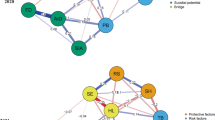Abstract
Objectives: Ethnographic literature on inner-city life argues that adolescents react to their uncertain (and objectively bleak) future by abandoning hope; this, in turn, leads them to engage in risk behaviors, including violence, with considerable frequency. This study empirically measures the pervasiveness of hopelessness and uncertainty about the future among inner-city adolescents and documents the link between hopelessness, uncertainty, and risk behavior. Methods: We surveyed a sample of 583 adolescents (aged 9–19) living in public housing in Huntsville, AL; this constitutes 80% of the eligible population. Each participant in the survey received $10. Their responses yielded empirical distributions for hopelessness, uncertainty about the future, and four violent behaviors. Using OLS regression, we examined the effect of hopelessness on these violent behaviors. Results: Hopelessness about the future was relatively rare, affecting only 20–30% of the respondents. However, it was a strong predictor of fighting and carrying a knife for females, and of carrying a knife, carrying a gun, and pulling a knife or gun on someone else for males. Uncertainty about the future was more prevalent, but unrelated to the violent behaviors. Conclusions: These results suggest that the conclusions of the ethnographic literature are only partially valid: While hopelessness is, in fact, strongly related to risk behavior, it is not nearly so prevalent as is generally assumed.
Similar content being viewed by others
REFERENCES
Jargowsky PA. Poverty and place: Ghettos, barrios, and the American city. New York: Russell Sage, 1997.
Harrison B, Bluestone B. The great u-turn: Corporate restructuring and the polarizing of America. New York: Basic, 1988.
Kasarda JD. Urban industrial transition and the underclass. Ann Am Acad Polit Soc Sci 1989;501:26–47.
Jargowsky PA, Bane MJ. Ghetto poverty: Basic questions. In: Lynn LE, McGeary MGH, editors. Inner-city poverty in the United States.Washington, DC: National Academy, 1990.
Miller JG. Search and destroy: African-American males in the criminal justice system. Cambridge: Cambridge University Press, 1996.
Fordyce EJ. Urban mortality-race or place? Stat Bull 1996; 77(2):2–10.
Collins JG. Prevalence of selected chronic conditions: United States, 1986-1988. Vital Health Stat 1993;10:182.
Herson LJR, Bolland JM. The urban web: Politics, policy, and theory, 2nd ed. Chicago: Nelson-Hall, 1998.
Lewis O. La vida: A Puerto Rican family in the culture of poverty-San Juan and New York. NewYork: Random House, 1965.
Liebow E. Tally's corner: A study of negro streetcorner men. Boston: Little Brown, 1967.
Banfield EC. The unheavenly city revisited. Boston: Little Brown, 1974.
MacLeod J. Ain't no makin' it: Leveled aspirations in a lowincome neighborhood. Boulder, CO: estview, 1987.
Kotlowitz A. There are no children here: The story of two boys growing up in the other America. New York: Doubleday, 1991.
Peterson PE. The urban underclass and the poverty paradox. In: Jencks C, Peterson PE, editors. The urban underclass. Washington, DC: Brookings, 1991.
Anderson E. The story of JohnTurner. In: Harrell AV, Peterson GE, editors. Drugs, crime, and social isolation: Barriers to urban opportunity. Washington, DC: Urban Institute, 1992.
Lorion RP, Saltzman W. Children's exposure to community violence: Following a path from concern to research to action. Psychiatry 1993;56:55–65.
Lau S, Lau W. Outlook on life: How adolescents and children view the life-style of parents, adults, and self. J Adolesc 1996;56:293–6.
Bell CC, Jenkins EJ. Community violence and children on Chicago's southside. Psychiatry 1993;56:46–54.
Friedlander B. Community violence, children's development, and mass media: In pursuit of new insights, new goals, and new strategies. Psychiatry 1993;56:66–80.
Garbarino J, Dubrow N, Kostelny K, Pardo C. Children in dangerous environments: Coping with the consequences of community violence. Chicago: Jossey-Bass, 1992.
Jenkins CD. While there's hope, there's life. Psychosom Med 1996;58:122–4.
Wilson WJ. When work disappears: The world of the new urban poor. New York: Knopf, 1996.
DuRant RH, Cadenhead C, Pendergrast RA, Slavens G, Linder CW. Factors associated with the use of violence among urban black adolescents. Am J Public Health 1994;84:612–7.
DuRant RH, Pendergrast RA, Cadenhead C. Exposure to violence and victimization and fighting behavior by urban black adolescents. J Adolesc Health 1994;15:311–8.
DuRant RH, Getts AG, Cadenhead C, Woods E. The association between weapon-carrying and the use of violence among adolescents living in or around public housing. J Adolesc 1995;18:579–92.
DuRant RH, Getts AG, Cadenhead C, Emans SJ, Woods E. Exposure to violence and victimization and depression, hopelessness, and purpose in life among adolescents living in and around public housing. J Dev Behav Pediatr 1995;16:233–7.
Kazdin AE, French NH, Unis AS, Esveldt-Dawson K, Sherick RB. Hopelessness, depression, and suicidal intent among psychiatrically disturbed inpatient children. J Consult Clin Psychol 1983;51:504–10.
Kazdin AE, Rodgers A, Colbus D. The hopelessness scale for children: Psychometric characteristics and concurrent validity. J Consult Clin Psychol 1986;54:241–5.
McLoyd V, Wilson L. The strain of living poor: Parenting, social support, and child mental health. In: Huston HC, editor. Children in poverty. New York: Cambridge University Press, 1991.
Jencks C, Mayer SE. The social consequences of growing up in a poor neighborhood. In: Lynn LE, McGeary MGH, editors. Inner-city poverty in the United States. Washington, DC: National Academy, 1990.
Schussler KF. Measuring social life feelings. San Francisco: Jossey-Bass, 1982.
Lamborn SD, Mounts NS, Steinberg L, Dornbusch SM. Patterns of competence and adjustment for authoritative, authoritarian, indulgent, and neglectful families. Child Dev 1991;62:1049–65.
Author information
Authors and Affiliations
Corresponding author
Rights and permissions
About this article
Cite this article
Bolland, J.M., McCallum, D.M., Lian, B. et al. Hopelessness and Violence Among Inner-City Youths. Matern Child Health J 5, 237–244 (2001). https://doi.org/10.1023/A:1013028805470
Issue Date:
DOI: https://doi.org/10.1023/A:1013028805470




